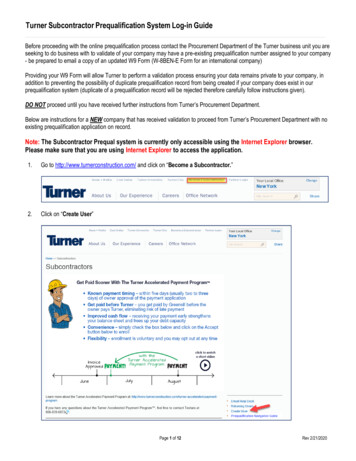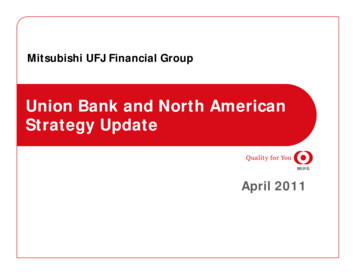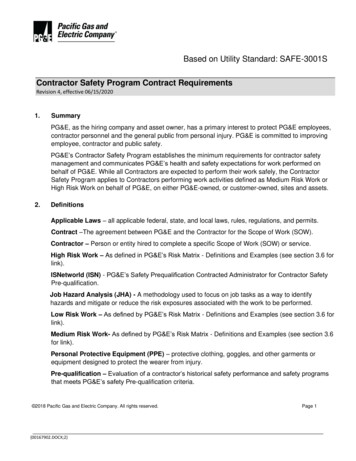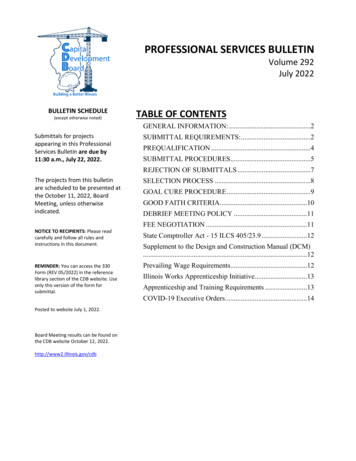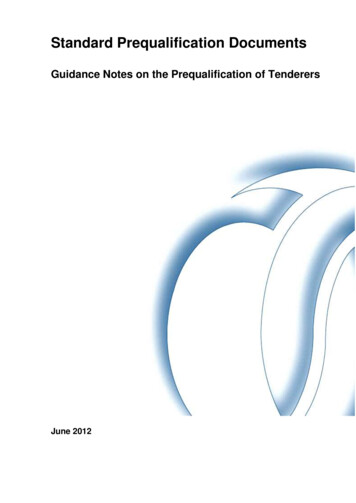
Transcription
Standard Prequalification DocumentsGuidance Notes on the Prequalification of TenderersJune 2012
EBRDGuidance Notes on the Prequalification of TenderersGUIDANCE NOTES ON THE PREQUALIFICATION OF TENDERERSPREFACEProcurement under projects financed by the European Bank for Reconstruction andDevelopment (the Bank) is carried out in accordance with the procedures laid down in theBank’s Procurement Policies and Rules.The Standard Prequalification Documents have been prepared for the use by the Bank’spublic sector clients for the procurement of construction works, complex goods, services orengineering systems in projects financed by the Bank.These Guidance Notes are prepared to complement the Standard PrequalificationDocuments in order to explain the reasons for this procedure and its advantages, and toprovide general guidance to clients and their consultants.The Guidance Notes are for the exclusive use of the clients and should not be included inthe Prequalification Documents made available to applicants.Care should be taken when preparing prequalification documents to ensure that theprequalification criteria refer to the needs and characteristics of the specific contract/project,while being consistent with the general principles outlined in these Guidance Notes.These Guidance Notes shall also be consulted while drafting the post-qualification part of thetender documents, as the same principles and methodology should be applied.Additional information on procurement for projects financed by the Bank can be obtainedfrom:Procurement DepartmentEuropean Bank for Reconstruction and DevelopmentOne Exchange SquareLondon EC2A 2JNUnited KingdomTelephone: 44 20 7338 6000Facsimile: 44 20 7338 74721
EBRDGuidance Notes on the Prequalification of TenderersTABLE OF CONTENTS1. Competitive Tendering for Construction Works, Supply of Complex Goods,Services or Engineering Systems2. Requirement for Prequalification of Tenderers3. Benefits of Prequalification4. Basis for Prequalification5. Eligibility to Prequalify6. Co-Financed Projects7. Two-Envelope System8. Multiple Contracts9. Subcontractors10. Consortia and Other Forms of Association11. Parent Companies’ Credentials12. Advertisement and Time Period13. Review by the Bank14. Clarifications15. Amendment of Prequalification Documents16. Information to be Sought17. Pass/Fail Criteria18. Typical Qualification Criteria18.1 Legal Status18.2 General Experience18.3 Particular Experience18.4 Current Obligations and Pending Awards18.5 Personnel Capabilities18.6 Equipment Availability18.7 Manufacturing Capacity18.8 Financial Position18.9 Litigation History18.10 Specific Requirements with regard to JVCA19. Conditional Prequalification20. Late Applications21. Prequalification Report22. Lack of Competition23. Notification of the Outcome of Prequalification24. Updating Prequalification Information25. Invitation to Tender26. Repeating the 414161617171718181819192
EBRDGuidance Notes on the Prequalification of TenderersGUIDANCE NOTES ON THE PREQUALIFICATION OF TENDERERS1.Competitive Tendering for Construction Works, Supply of Complex Goods,Services1 or Engineering Systems1.1The successful execution of contracts for large building, civil engineering, supplyand installation projects, and major complex custom-made equipment, complex orunique services requires that contracts are awarded to competent contractors,usually on the basis of competitive tendering procedures. Large contracts financedunder loans from the European Bank for Reconstruction and Development areawarded, as a rule, through open tendering.2.Requirement for Prequalification of Tenderers2.1This document relates specifically to the selection of competent tenderers, prior tothe issue of the invitations to tender, a procedure known as prequalification.Prequalification of contractors is recommended for large or complex works and forcustom-designed equipment or systems and specialised services. Prequalificationcan also be used in other circumstances, for example, in sector projects financingannual programmes under a multi-year capital investment plan, and when a largenumber of contracts are tendered and let as one or more lots (“slice andpackaging”) or as the basis of framework arrangements.2.2The qualification of a tenderer is a process distinct from the tender evaluationprocedure, which concentrates on the price and merits of the specific tender itself.For further details of the tender evaluation procedure, refer to the relevant StandardTender Documents of the Bank and the Bank’s Guidance Note - Opening andEvaluation of Tenders. The qualification process is focused on qualification,experience and capability of the tenderers to implement the resulting contractssatisfactorily.2.3The main purpose of prequalification is to select those contractors/suppliers, whosequalifications and experience would minimise the risk of non-performance under theproposed project/contract.3.Benefits of Prequalification3.1The prequalification process is of advantage to tenderers and clients alike.3.2The prequalification process enables tenderers who may be insufficiently qualifiedon their own to avoid the expense of tendering or to enter into a joint venture,consortium, or association (JVCA), which may have a better chance of success, orconsider working as a sub-contractor on the project. The well-qualified firms mayalso price their tenders with the knowledge that they will be competing with otherqualified tenderers meeting appropriate minimum competence criteria. Theassurance that competitors lacking the necessary qualifications will be excludedfrom tendering thus encourages leading contractors or suppliers to tender.1The services are any services, except consulting services, for example operation and maintenance ofroads or plants, design, geotechnical surveys etc.3
EBRD3.3Guidance Notes on the Prequalification of TenderersPrequalification enables clients: to select potential contractors/suppliers, who meet project/contract specificqualification criteria and, therefore, are deemed to be capable of performing theproject/contract satisfactorily; to assess the interest generated by the project among qualified firms, and tomake any necessary adjustments to the procurement process (including, inparticular, the evaluation methodology, the conditions of contract sharing ofrisk, payment terms, liquidated damages, warranty or completion times, whichmay be perceived as onerous by potential tenderers); to reduce the amount of work and time involved in evaluating tenders fromunqualified contractors or suppliers; to encourage local firms to form JVCA with other local or foreign firms, therebybenefiting from their resources and experience; and to eliminate or significantly reduce problems associated with low prices submittedby tenderers of doubtful capability.4.Basis for Prequalification4.1Under Bank-financed projects, the Bank’s clients (the “Client” in this document) areresponsible for preparing the prequalification documents and evaluating theapplicants. The prequalification documents should provide a clear basis upon whichprospective tenderers can be evaluated, following an objective process based onfair and transparent criteria. The documentation sought should always be relevant,clearly stated and, so as not to deter prospective tenderers, should not impose anexcessive burden of preparation or paperwork.4.2Prequalification should be denied only to those prospective tenderers who do notmeet all or critical aspects the specified criteria. Thus, those who prepareprequalification documentation for a project are responsible for ensuring that thecriteria are drawn up in accordance with the appropriate needs of the project andthat the criteria are balanced and sufficiently stringent to assure that only properlyqualified firms are included in the final list. Excessively ‘soft’ criteria may result in anexcess of unsuitably qualified applicants and may lead to (a) deterring the betterqualified firms from tendering and (b) low priced tenders from under-qualifiedcontractors or suppliers. At the same time excessively ‘strict’ criteria may seriouslyhamper competition, limit participation of local companies in the tender and lead tocomplaints.4.3The Bank does not accept blanket ‘blacklisting’ of contractors or suppliers. Inprinciple, a firm that did not perform well in a prior contract should be permitted totender for subsequent tenders if it can demonstrate that it has corrected theproblems that caused its prior poor performance. The evaluation of applicants forprequalification must therefore be based on the evidence submitted by the applicantwithout reference to blacklists, which may be based on out-of-date oruncorroborated information or irrelevant data. At the same time, if an applicant isformally debarred from contracting activities by the law or official regulation of thecountry, and the Client may not enter into a contract with such applicant, the Clientmay reject the application. In such cases the Bank shall be provided with a copy ofan official record/court decision confirming the debarment. Current poorperformance or negative litigation history with the Client may be a reason fordisqualifying an applicant, provided such judgment is supported by official impartial4
EBRDGuidance Notes on the Prequalification of Tenderersrecords/court decisions. Such action would have to be reviewed by the Bank on acase-by-case basis.4.4Since prequalification is a preliminary stage in the process of awarding a contract toa competent tenderer, the Client must be able to verify the statements made by theapplicants and to solicit information from past clients and financial institutions.Because there may be many applicants at the prequalification stage, the extent ofverification should be limited to significant issues and applicants should be affordedthe benefit of reasonable doubt. In subsequent stages of the procurement process,such doubts may be investigated if they remain relevant. In view of the above, theBank strongly advocates an ‘inclusive’, rather than an ‘exclusive’ approach duringthe prequalification exercise. Only deviation from critical criteria caused by activitieswhich occurred in the past, and which applicants therefore can not change, shall beused as a basis for rejection of applicants. Otherwise applicants shall be asked toprovide lacking documents (such as absent forms, letters, balance sheets etc.) torectify omissions during evaluation. Applicants shall also be given an opportunity toresolve deviations identified during prequalification at a later stage; this processknown as ‘conditional prequalification’ is described in paragraph 19 below.5.Eligibility to Prequalify5.1The prequalification process shall not be used to limit arbitrarily the number oftenderers, and all prequalified applicants must be permitted to tender. Somecountries maintain registers of firms that meet pre-set qualification requirements.Such registers are not a substitute for the prequalification process under opentendering for a specific contract or project.5.2Prequalification in Bank-funded projects is open to contractors, suppliers and JVCAfrom any country or countries.5.3No affiliate of the Client shall be eligible to tender or participate in a tender in anycapacity whatsoever unless it can be demonstrated that there is not a significantdegree of common ownership, influence or control amongst the Client and theaffiliate2.5.4Where a firm, its affiliates or parent company, in addition to consulting also has thecapability to manufacture or supply goods or to construct works or provide services,that firm, its affiliates or parent company normally cannot be a supplier of goods,works or services on a project for which it provides consulting services, unless it canbe demonstrated that there is not a significant degree of common ownership,influence or control between the consulting firm and the supplier or the contractor.5.5The proceeds of the Bank’s loans, equity investments or guarantees shall not beused for payments to persons or entities or for any import of goods, if such paymentor import is prohibited by a decision of the United Nations Security Council takenunder Chapter VII of the Charter of the United Nations, or as a matter of law orofficial regulation, the Client’s country prohibits commercial relations with the firm’scountry, provided that the Bank is satisfied that such exclusion does not precludeeffective competition.5.6A company shall not be eligible to participate in prequalification in any capacitywhatsoever where it has been determined that it has engaged in prohibited2Affiliate means, in relation to an entity (the First Entity), any entity controlled, directly or indirectly, bythe First Entity, any entity that controls, directly or indirectly, the First Entity or any entity directly orindirectly under common control with the First Entity.5
EBRDGuidance Notes on the Prequalification of Tendererspractices as defined in the Bank’s Procurement Policies and Rules. Therefore,applications from any firm included in the Bank’s List of Ineligible Entities andsubject to a debarment must be rejected.The List of Ineligible Entities may be found on the following Bank’s s/integrity/list.shtml.6.Co-Financed Projects6.1Individual contracts may be financed jointly by the Bank and other lenders. Theprocurement process is normally the same as in any contract funded solely by theBank.6.2In cases, where contracts are co-financed on a parallel basis, the co-financiers'procurement procedures shall normally be applied for contracts financed by them.The prequalification documents must address the requirements of the co-financiersin respect of the contracts they finance.6.3.In some cases, the co-financing arrangements (including the extent of theparticipation of the various co-lenders, the allocation of their funds to the variousdiscrete elements of the project, and the extent to which joint co-financing will apply)may not have been determined at the time of inviting firms for prequalification, andtherefore the prequalification requirements for the various elements of the projectare not yet known. The prequalification documents should disclose to the applicantsthe possibility of subsequent subdivision of the project into separate contracts for apotential parallel co-financing arrangement.7.Two-Envelope System7.1The evaluation of prequalification applications precedes the issue of Invitations toTender. Procedures such as the ‘two-envelope system’, which entails submittingPrequalification and Tender Documents at the same time, in separate envelopes,defeat one of the key objectives of prequalification, i.e. saving unqualifiedprospective tenderers the expense of tendering. The two-envelope system,therefore, may not be used.8.Multiple Contracts8.1Where a project may be divided into separate contracts (lots/slices) that may becombined into groups of contracts (packages), applicants may be invited toprequalify for each specific contract separately, or for a package of contracts whichmay be essentially of a similar type and size. Applicants should be prequalified for aspecific limit, either by aggregate value or number of contracts, based on theirdemonstrated competence.8.2An applicant should be allowed to tender for any contract or contracts within thevalue limit for which it is prequalified. However, it may only be awarded anaggregate value or number of contracts for which it was prequalified.9.Subcontractors9.1The turnover and financial resources of subcontractors shall be disregarded for thepurposes of prequalification, as they will not be a party to the resulting contract.However, their specific experience related to the contract and/or availability oflicences, required by the law of the country, where the works are to be carried out,may be taken into account during prequalification.6
EBRDGuidance Notes on the Prequalification of TenderersAt the same time the cumulative experience and capacity of an applicant gained asa former subcontractor for certain works, depending on the extent of hisinvolvement, scope, nature and magnitude of the works, services or supply shouldalso be considered. In cases where a specialised process is needed, applicantsshould be required to specify the names and qualifications of such specialistsubcontractors, if the particular process is not available in-house. Lack of suchspecialised support, essential in certain construction operations that require, forexample, design, installation and commissioning of specialised engineering systemsor underwater repair work, could result in disqualification of the applicant.9.2The Bank does not support arbitrarily set limits for subcontracting. At the same timethe contractors/suppliers shall not subcontract the whole works/supply. Thequalified tenderers should be capable to arrange the works/supply in the mostefficient and economic way, regardless as to whether they engage their ownresources or use subcontractors.Under any circumstances the contract conditions shall provide for thecontractors/suppliers to remain responsible for implementing the contracts in time,with due quality and within the agreed price.9.3In addition to the assessment of the qualification of the applicants, the Client mayalso assess the qualification of subcontractors in respect to the works/supply theyare proposed by the applicant to be engaged in. Normally such assessment shallonly be focused on the subcontractors for critical components of the works or forworks in excess of 10 percent of the value of the whole works. The evaluation of thesubcontractor’s qualification shall mirror that of the applicant with the criteriareduced pro rata to the scope of the respective works/supply. Should asubcontractor be determined to be unqualified or otherwise unacceptable, theapplication shall not be rejected, but the applicant shall be required to substitute theunqualified subcontractor with an acceptable subcontractor. In many cases it maybe more efficient to assess the subcontractor’s qualification at the tendering stage,when the scope and terms of the works/supply are well defined, as opposed to theprequalification stage, when only general information and basic design of theproject are usually available.10.Consortia and Other Forms of Association10.1The Bank encourages the formation of a JVCA of contractors or suppliers, but doesnot accept conditions for prequalification or tendering which make such JVCAmandatory.10.2When two or more firms apply jointly for prequalification, special considerationsmust be met. The prequalification documents must clearly set out the conditionsapplying to such a JVCA, whether existing or proposed; to any change in thecomposition of a JVCA; or to the association of prequalified firms afterprequalification. Each party of a JVCA must submit the complete documentationrequired of individual firms applying for prequalification.10.3The requirements described for a JVCA apply to associations, partnerships,consortia, and other ventures in which firms associate with each other formally forthe purpose of jointly carrying out a contract without registering a legal entity.Partners of a JVCA must confirm that, if prequalified, the JVCA tender will besubmitted with a formal JVCA agreement and that all parties to that agreement willbe jointly and severally liable for the tender and any consequent contract. The leadpartner in the JVCA should also be designated, as well as the individual, with overall7
EBRDGuidance Notes on the Prequalification of Tenderersresponsibility for the joint application, who will be the principal contact forcommunications. These requirements do not apply to subcontracting arrangements.10.4A firm may apply for prequalification both individually and as part of one or moreJVCA. However, a prequalified firm or member of a prequalified JVCA mayparticipate as a tenderer in only one tender, either individually or as a partner in aJVCA, for the contract. Submission or participation by a firm in more than onetender for a contract (other than alternatives which have been permitted orrequested) will result in the disqualification of all tenders for that contract in whichthe party is involved.10.5Formation or regrouping of a JVCA after prequalification will only be considered ifthe additional firms or JVCA have been prequalified. However, such new JVCA willnot be approved if, in the Client's or the Bank’s opinion, this would substantiallyreduce competition.10.6If an applicant is a JVCA of firms, who associate with each other formally for thepurpose of carrying out a contract jointly through registering a legal entity/thespecial purpose vehicle (the SPV), the qualification of the founders shall bedisregarded, until and unless the application is supported by the parent companies’unconditional guarantees for due performance.11.Parent Companies’ Credentials11.1If an applicant is a JVCA of firms, which associate with each other formally for thepurpose of carrying out a contract jointly through registering a legal entity/the SPV,or a branch of a large parent company, the qualification of their founders or parentcompanies shall be disregarded, unless the application is supported by the parentcompany’s unconditional guarantee of due performance of all thecontractor’s/supplier’s obligations and liabilities under the resulting contract (similarto a sample parent company guarantee included in FIDIC Conditions of Contract,Annex A).11.2In case an appropriate parent company’s written commitment is submitted, thequalification of the parent company shall be evaluated in a way similar to theassessment of the qualification of applicants or JVCA members, as described inthese Guidance Notes.11.3Subject to satisfactory assessment, the prequalification of applicants shall beconditional upon submitting the parent company guarantee with their tenders andmaintaining it throughout contract implementation.12.Advertisement and Time Period12.1The prequalification of tenderers should be advertised following the procedures fornotification and advertising specified in the Bank’s Procurement Policies and Rules.12.2Adequate time for response should be allowed. Consistent with the WTO/GPAprovisions the period for submitting applications shall not be less than 25 days fromthe date of publication of the notice. The time for preparing and submittingapplications for a particular contract/project shall depend on its nature andcomplexity.12.3It is strongly recommended that the prequalification documents are to bedisseminated free of charge in electronic format, wherever possible. In case the8
EBRDGuidance Notes on the Prequalification of Tenderersdocuments are distributed in hard copy only a nominal fee should be charged, solelyto cover the costs of reproduction and of dispatching the documents by courier.13.Review by the Bank13.1Prior to inviting companies to prequalify, the Client is required to submit thecomplete prequalification documents to the Bank for its review and no-objection.The Client shall use the Bank’s Standard Prequalification Documents as a basis forthe preparation of the specific prequalification documents. The Client shall makesuch modifications in the documents, as the Bank requests. The approveddocuments shall not be changed without the Bank’s no-objection.13.2The specific criteria, and the prequalification document as a whole, must beconsidered with care as early as possible in the procurement process. However, theprequalification documents should be issued only when the preparation ofengineering designs and the procurement strategy is well advanced, and the works,goods or services are reasonably well defined. The timing of the prequalificationshall be well planned, as the time period between prequalification and the tenderingshall not be too long as to affect the interest of prequalified companies to tender, orto provide for substantial changes of the market conditions or projectcircumstances. In the latter cases the prequalification exercise may need to berepeated.14.Clarifications14.1.A prospective applicant requiring any clarification on any aspect of theprequalification documents or process may solicit clarifications from the Client. TheClient shall normally respond to requests for clarification in advance of the deadlinefor application submission. Copies of the Client’s response shall be sent to allprospective applicants. All correspondence between the Client and applicants shallbe in writing.14.2Where circumstances warrant (usually for very large or very complex projects), aclarification meeting should be held to clarify any queries of the potential applicantsabout the documents or the project. If such a meeting takes place, all firms thathave obtained prequalification documents should be sent, at least two weeks beforethe submission date, a copy of the minutes of the meeting, listing any additionalinformation and/or changes made to the prequalification requirements or procedure,as a result of the meeting.14.3To assist in the examination and evaluation of applications the Client may, at itsown discretion, ask any applicant for clarification of its application. Such clarificationmay be requested in writing at any stage up to the notification of the outcome of theprequalification.15.Amendment of Prequalification Documents15.1At any time prior to the deadline for submission of applications, the Client mayamend the prequalification requirements or procedure by issuing an amendment tothe prequalification documents. Any amendment shall be part of the prequalificationdocuments and shall be communicated in writing to all prospective applicants. Allamendments shall be subject to the Bank’s review and no-objection prior to issue.15.2To give prospective applicants reasonable time in which to take an amendment intoaccount in preparing their applications, the Client may, at its own discretion, extendthe deadline for the application submission.9
EBRDGuidance Notes on the Prequalification of Tenderers16.Information to be Sought16.1To enable potential tenderers to be prequalified, it is necessary to seek only suchinformation essential for the Client to determine the applicant's capabilities toperform the contracts satisfactorily. These capabilities are normally established inrespect of experience, personnel capabilities, equipment capabilities, financialposition, litigation history, JVCA arrangements, critical subcontracting, and currentcommitments.16.2The minimum amount of information to determine the applicant's capabilities toperform the contracts satisfactorily shall be solicited. During evaluation theapplicants may be requested and shall be allowed to provide additional criticalinformation prior to the Client’s final determination in respect of their qualification.17.Pass/Fail Criteria17.1The Bank strongly advocates that tenderers should be prequalified by meetingpredefined and precise minimum requirements. The method entails settingPass/Fail criteria which, if not substantially met by the applicant, results indisqualification. These criteria must be set so that they neither inhibit competitionnor set a predetermined number of firms to be prequalified, as all firms that meetthe criteria should be invited to tender. Other methods, that involve the use ofsubjective criteria, or are based on an imprecise merit point system to evaluatefirms, have been found to be flawed. They have often resulted in complaints frompotential tenderers that were unjustly disqualified, and have lead to serious delaysin project implementation.17.2The criteria adopted must relate to characteristics that are essential to ensure asatisfactory execution of the contract, and must be stated in unambiguous terms. Inessence, the criteria must be chosen so that only applicants who are well qualifiedto carry out the contracts are permitted to tender. The prequalification criteria forJVCA applicants should be the same as those for single applicants.17.3Some qualification criteria may reflect arrangements for the specific contract, whichcan be amended by the applicants in the future prior to submission of their tenders(for example, improving critical project management; access to specialisedequipment; the substitution of a critical specialist supplier or subcontractor). Withregard to these Pass/Fail criteria, the applicants may be prequalified conditionally.18.Typical Qualification Criteria18.1Legal Status18.1.1The applicants may be requested to provide their charter andregistration/incorporation documents. An existing JVCA shall be required to providea copy of the JVCA agreements, which they shall be allowed to change at thetendering stage. A prospective JVCA, as a minimum, shall provide a letter of intentto form a JVCA at the tendering stage, signed by all partners. In this letter partnersof the prospective JVCA must confirm that, if prequalified, their tender will besubmitted with a formal JVCA agreement and that all parties to that agreement willbe jointly and severally liable for the tender and any consequent contract. The leadpartner in the JVCA should also be designated, as well as the individual with overallresponsibility for the joint application, who will be the principal contact forcommunications.10
EBRDGuidance Notes on the Prequalification of Tenderers18.1.2When the law of the country, where the project is implemented, requires theapplicant to have licences for the activities to be undertaken under the contract, orbe a member of self regulating associations, the Clients may request the applicantsto submit copies of the appropriate licences and/or association membership. Ifsome of the above mentioned activities are to be carried out by subcontractors, theirlicences and/or association membership are to be submitted with applications.However, if the applicants do not possess s
prequalification documentation for a project are responsible for ensuring that the criteria are drawn up in accordance with the appropriate needs of the project and that the criteria are balanced and sufficiently stringent to assure that only properly qualified firms are included in the final list. Excessively 'soft' criteria may result in an
